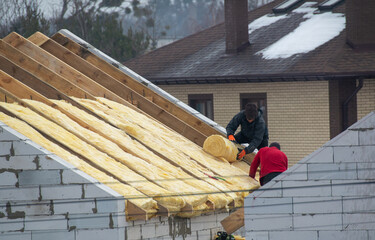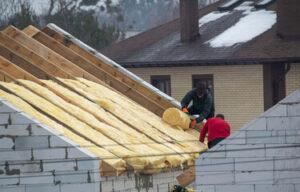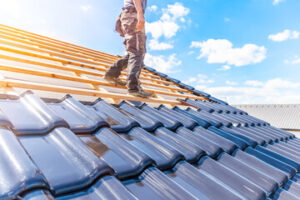Anderson Roofing and Exteriors protect us from the elements and enhance the appearance of our homes. However, over time, old, deteriorating materials can leave your home vulnerable and needing repair.
A roof is the covering of the top of a building that protects against rain, snow, sunlight, wind, and extreme temperatures. It can be flat, pitched, vaulted, or domed and constructed from various materials.

The roof is an essential component of a building. It protects against rain, snow, sunlight, and extremes of temperature. It also helps to make the structure more aesthetically appealing. However, a deteriorating roof can expose a home to costly damage and loss of comfort. In addition, it can result in leaks, mold and mildew growth, poor ventilation, and structural support problems. Therefore, replacing a faulty or aging roof as soon as possible is important.
The cost of a new roof will depend on several factors, including the materials, size, and complexity. Some of these costs are beyond a homeowner’s control, but others can be. For example, the choice of shingle type or alternate material significantly affects the overall cost. However, the most basic asphalt shingles are affordable and durable enough for most homeowners.
Other features, such as chimneys, soffits, and vents, add to the cost of a new roof. They may require special flashing and caulking and can increase the price of the materials. In addition, skylights and dormer windows add to the roof’s weight and cost. These additions can affect the structural integrity of a roof, so it’s important to consult a professional before adding them.
In addition to increasing the value of your home, a new roof can save you money on your energy bills. It can keep the heat in during cold weather and prevent unwanted heat loss. A new roof can significantly reduce the time you spend heating your home during winter.
If you’re considering selling your property, a new roof can also help boost its resale value. It’s something that buyers will look for and be willing to pay a premium for.
It’s not advisable to climb up on your roof to measure the square footage of your house, as it’s dangerous and difficult. The best way to determine the size of your roof is to hire a professional who can provide you with an accurate and thorough measurement. They’ll also be able to walk you through the options available, which can vary in cost and appearance.
The lifespan of roofs can vary based on a variety of factors. The material it is made from, its installation quality, and maintenance can all impact how long your roof will last before it needs replacing.
Asphalt shingle roofs have a lifespan of between 20 and 30 years. However, this depends on the type of shingles you choose and their manufacturer’s specifications. For example, architectural shingles tend to have longer lifespans than three-tab shingles. The climate where you live also affects the life span of your roof. Severe winters, humid summers, and frequent freeze-thaw cycles can significantly shorten your roof’s lifespan.
Metal roofs are becoming increasingly popular for residential roofing and have a lifespan of up to 80 years. This is especially true if you choose a high-quality option with thicker materials and better construction. Wood shingle roofs can last 25 to 30 years, depending on the materials used and how they are maintained. Wood shingle roofs should be treated with preservatives and regularly stained or painted to prevent mold, mildew, and moss growth.
Rubber roofs are another roofing option with a lifespan of up to 50 years and are ideal for colder climates. They are less prone to damage from sun and heat than other roofing types and require minimal yearly maintenance.
Slate roofs have one of the longest lifespan, ranging between 75 and 150 years. This type of roof is more expensive than other roofing options but can last a lifetime if properly maintained.
A good way to know if your roof is reaching the end of its lifespan is to look for gaps and cracks in the exterior walls, ceilings, and attic. Additionally, a shingle roof approaching the end of its lifespan may be less effective at keeping heat away from your home since older shingles are not designed to reflect the sun’s rays. Having a newer roof designed to keep heat away from your home can improve your home’s energy efficiency and comfort.
Roofs play a critical role in the overall look and feel of homes. They protect from heat, cold, and rain. They also tie in other home design elements and can be a focal point. They can even contribute to the energy efficiency of a house, depending on the color. For example, lighter colors reflect sunlight and lower air conditioning costs. However, it’s important to consider the climate in your area when choosing a roof color. Darker colors absorb more heat, which could cause your cooling bills to rise.
The exterior upper covering of a building shields against precipitation and may incorporate openings for lighting, ventilation, access, etc. It may be constructed in various forms, including flat, pitched, vaulted, domed, or in combinations, as dictated by technical, economic, or aesthetic considerations.
Many different types of roofs are available, each with its advantages and disadvantages. Some are made from a single material, while others use multiple materials. Some are designed as a living roof, with soil and plants as natural insulation. Others are made from cut turf (modern ones are known as green roofs and traditional ones as sod roofs).
Roofs can be built in a wide range of styles and are typically shaped to suit the needs of their users. They are often constructed from various materials selected for their durability, aesthetic appeal, and cost-effectiveness. Ideally, they should be easy to install and maintain. This will enable them to serve their purpose effectively and last long.
Roofs can have a significant impact on the environment. Traditional shingle roofs, for example, require a large amount of fossil fuels to manufacture. These fuels contribute to climate change and create greenhouse gasses. By switching to a sustainable roof, you can reduce your environmental footprint and save on energy costs. Additionally, new roofing can add to the resale value of your home and help you find buyers more easily.
Whether you’re thinking of selling your home or not, upgrading to a green roof is a good investment for the long term. This energy-efficient upgrade helps to limit heat loss and saves on air conditioning costs. These savings can quickly recoup the cost of the roof. In addition, sustainable roofs provide a great spot for solar panels to reduce your carbon footprint even further.
Green and cool roofs also contribute to reducing the urban heat island effect. These roofs use highly reflective and low emissive materials that keep the surface of buildings cooler than traditional ones during peak temperatures. They can also decrease energy demands and improve indoor comfort.
A metal roof can be made from recycled aluminum and is 99% recyclable at the end of its lifespan. This reduces the need to re-laminate with fresh aluminum and reduces manufacturing waste. Furthermore, metal roofs are fire-resistant and have a proven performance expectation of 50+ years.
Clay tile and concrete tiles have a lower carbon footprint and embodied energy demand than sheet-metal roofing. However, the need for local recycling facilities for these roof materials limits their recyclability.
In addition to their energy efficiency, green roofs can reduce water runoff and soil erosion, absorb pollutants, and provide a habitat for wildlife. They can also serve as recreational green spaces for the community and offer various other benefits.
If you’re concerned about your home’s environmental impact, a green or sustainable roof is a great option. It can reduce your electricity bills, protect your family’s health and the environment, and boost the resale value of your property.




